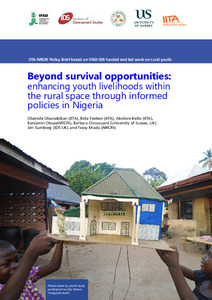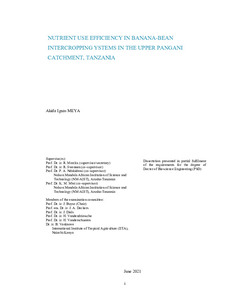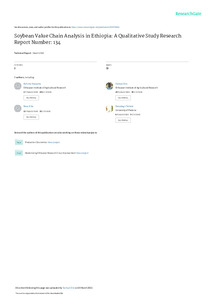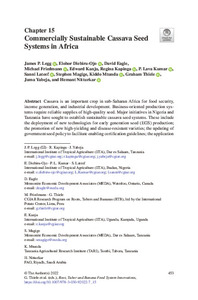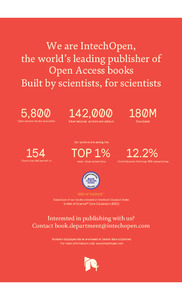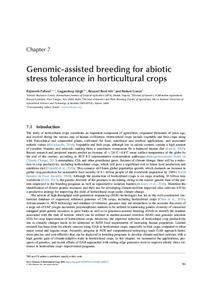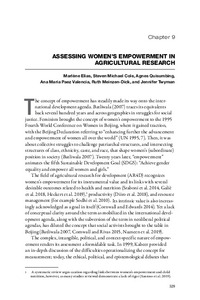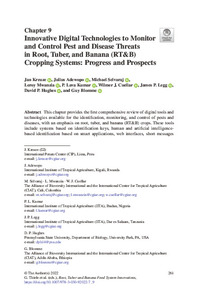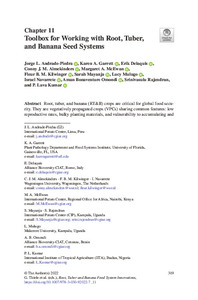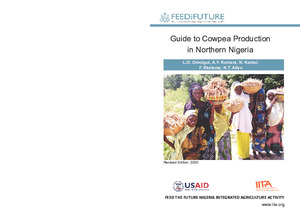Welcome to the International Institute of Tropical Agriculture Research Repository
Books and Book Chapters: Recent submissions
Now showing items 81-100 of 983
-
Impacts of CGIAR maize improvement in sub-Saharan Africa 1995-2015
(International Maize and Wheat Improvement Center, 2021-03) -
Genome engineering: a new frontier for improving root and tuber crops
(CRC Press, 2022) -
Nutrient use efficiency in banana-bean intercropping systems in the Upper Pangani catchment, Tanzania
(Katholieke Universiteit, Leuven, 2021-06)Banana is an important food staple and cash crop to millions of people in the humid highlands of Tanzania. Yield ranges between 5.7 and 14 tons per hectare, only attaining 27 % of its potential yield, mainly caused by low soil fertility. The accessible amounts of cattle manure conventionally used to replenish nutrient and manage soil fertility in banana home gardens are insufficient to meet nutritional crop requirements. Other animal manure e.g., poultry, goat and swine could be used to close the ... -
Soybean value chain analysis in Ethiopia: a qualitative study research
(Ethiopia Institute of Agricultural Research, 2022-03) -
Commercially sustainable cassava seed systems in Africa
(Springer, 2022)Cassava is an important crop in sub-Saharan Africa for food security, income generation, and industrial development. Business-oriented production systems require reliable supplies of high-quality seed. Major initiatives in Nigeria and Tanzania have sought to establish sustainable cassava seed systems. These include the deployment of new technologies for early generation seed (EGS) production; the promotion of new high-yielding and disease-resistant varieties; the updating of government seed policy ... -
Scaling readiness: learnings from applying a novel approach to support scaling of food system innovations
(Springer, 2022)Scaling of innovations is a key requirement for addressing societal challenges in sectors such as agriculture, but research for development programs struggles to make innovations go to scale. There is a gap between new complexity-aware scientific theories and perspectives on innovation and practical approaches that can improve strategic and operational decision-making in research for development interventions that aim to scale innovations. To bridge this gap, Scaling Readiness was developed. Scaling ... -
Cost-effective cassava processing: case study of small-scale flash-dryer reengineering
(Springer, 2022)The development and scaling out of flash-dryer innovations for more efficient, small-scale production of high-quality cassava flour (HQCF) and starch is described. The diagnoses of cassava-processing SMEs (small and medium enterprises) revealed their energy expenditures for drying were considerably higher than those of large-scale industrial companies, which was mostly due to suboptimal design of flash-drying systems. As a result, small-scale production of cassava starch and HQCF often incurs high ... -
A new paradigm in the delivery of modernizing agricultural technologies across Africa
(IntechOpen, 2021)This Chapter describes the approach and impacts of the Technologies for African Agricultural Transformation (TAAT) Program. TAAT is an operational framework based upon collaboration between the African Development Bank, the International Institute of Tropical Agriculture, and many other partners. This Program is designed to deliver modernizing agricultural technologies as a means of achieving food and nutritional security, and to boost employment and agricultural exports across Africa. TAAT consists ... -
Current and future advances in genomics-assisted cassava breeding
(CRC Press, 2022) -
Advances on engineering cassava for food and nutrition sec in the 21st century
(CRC Press, 2022) -
Blending climate action and rural development in Africa's Sahel
(IntechOpen, 2022)This paper describes the opportunity for combining climate action and improved food and nutritional security as mutual elements of rural development projects, with particular reference to the situation in the African Sahel. This progress is achieved by identifying climate-smart agricultural production technologies and bundling them into solutions for inclusion within larger projects and programs. Seventeen (17) such technologies are offered in this chapter that represent genetic innovations, ... -
Strategic plan for strengthening Oyo State food system during COVID-19 pandemic
(International Institute of Tropical Agriculture, 2020) -
Gender-disaggregated seasonal and daily calendars of farmers in Uganda and Tanzania
(Bioversity International, 2021-08) -
Genomic-assisted breeding for abiotic stress tolerance in horticultural crops
(Woodhead Publishing, 2021)Horticultural crops, including fruits and vegetables, form a major source of nutrition containing minerals and vitamins for humans and have been primarily cultivated since thousands of years of domestication. Their production has crossed the 10 billion tons mark value signifying their massive demand in the market. However, they are adversely affected by various abiotic stresses such as drought, heat, salinity, and cold, which are adversely affecting their production. This highlights serious and ... -
Assessing women's empowerment in agricultural research
(International Food Policy Research Institute, 2021) -
Innovative digital technologies to monitor and control pest and disease threats in Root, Tuber, and Banana (RT&B) cropping systems: progress and prospects
(Springer, 2022)This chapter provides the first comprehensive review of digital tools and technologies available for the identification, monitoring, and control of pests and diseases, with an emphasis on root, tuber, and banana (RT&B) crops. These tools include systems based on identification keys, human and artificial intelligence-based identification based on smart applications, web interfaces, short messages services (SMS), or combinations thereof. We also present ideas on the use of image recognition from ... -
Toolbox for working with root, tuber, and banana seed systems
(Springer, 2022)Root, tuber, and banana (RT&B) crops are critical for global food security. They are vegetatively propagated crops (VPCs) sharing common features: low reproductive rates, bulky planting materials, and vulnerability to accumulating and spreading pathogens and pests through seed. These crops are difficult to breed, so new varieties may be released slowly relative to new emerging threats. VPC seed systems are complex and face several challenges: poor-quality seed of existing varieties, low adoption ... -
Guide to cowpea production in northern Nigeria
(International Institute of Tropical Agriculture, 2020) -
Guide to soybean production in northern Nigeria
(International Institute of Tropical Agriculture, 2020-02)

